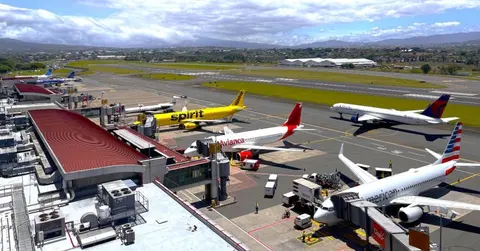Costa Rica could receive up to 12 million passengers per year by the end of the decade.
The International Air Transport Association (IATA) believes the passenger volumes in Costa Rica will more than double by 2030, going from approximately four million passengers currently to between ten and 12 million passengers. The Central American country has, at the moment, 507 weekly flights operated by 25 airlines.
This week, IATA held an Aviation Day event in San José, Costa Rica, in which it presented growth figures showing the industry could more than double the passenger volumes in the next seven years.
Nonetheless, to accommodate this future demand growth, it is crucial for Costa Rican authorities to continue collaborating closely with the aviation sector to ensure that the country is adequately prepared to manage the projected passenger growth, said IATA.
During the first half of 2023, Costa Rica received 1.3 million tourists, surpassing the pre-pandemic traffic figures. The industry creates about 160,000 direct jobs. About 90% of all tourists visiting Costa Rica enter onboard a scheduled passenger flight. In the last few months, the Central American country has gained new international connectivity with new routes to destinations such as Austin, San Francisco, Zurich, Cartagena, Quito, Chicago, Medellín, New York, Denver, Montreal, and Washington.
A booming market
The Latin American region has plenty of room to grow, with many countries having low yearly trips per capita. Peter Cerdá, IATA’s regional vice president in the Americas, said Costa Ricans enjoy traveling, as evidenced by the country’s per capita travel statistics, which is about 1.3 trips per year. This figure is above the regional average of 0.45 trips per year. But there’s room for growth. He added,
“If we look further north, Americans take 2.6 trips per year, and in Europe, Spaniards take 4.4 trips per year. Our goal should be to make air travel as accessible as possible for all residents of Costa Rica and thus promote economic development.”
Peter Cerdá urged the Costa Rican government to invest in the airport infrastructure while guaranteeing the country remains competitive in terms of taxes and fees. Costa Rica should not repeat the same mistakes that other countries in the region have made, such as Argentina and Colombia, where ill-taken measures led to rising fares, fewer passengers, and connectivity loss.
Costa Rican connectivity
The Central American country has direct connectivity and weekly operations from 25 airlines, which operate about 507 weekly flights in and out of the country. In terms of seats available, Avianca is the main airline in the country, offering 13,832 weekly seats and about 77 weekly flights. Copa Airlines and Volaris Costa Rica are the next two largest airlines by seat offering, with 10,784 and 7,977 weekly seats.
Costa Rica’s most important route is San Jose-Panama City (Tocumen), with 58 weekly flights connecting two of Central America’s most important cities. Domestically, the most important route is San José-Tambor, with 42 weekly flights (solely operated by Costa Rica Green Airways).
Costa Rica has direct connectivity on 18 routes to the United States. The most important are services from San Jose to Fort Lauderdale (21 weekly flights), Miami (15), Orlando (14), and Houston (14). San José also has direct connectivity to Atlanta, Los Angeles, New York, Houston Hobby, Newark, and Dallas. The other Costa Rican city with connectivity to the United States is Liberia, which has flights to Atlanta, Miami, Los Angeles, Houston, Dallas, New York, and Charlotte. (https://simpleflying.com/iata-costa-rica-double-passenger-traffic-20230/)


































